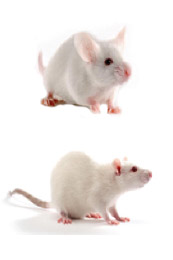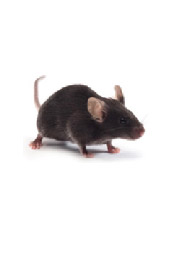
A strain is defined as inbred when it has been mated brother x sister for 20 or more consecutive generations (F20). All offspring can be traced back to a single ancestral breeding pair in the 20th or subsequent generation. Such inbred strains are therefore isogenic (genetically identical)Each inbred strain has a unique genotype and consequently a unique phenotype. Phenotypical differences between inbred strains should be taken into account when designing experiments. Specific strains have been developed for a high incidence of tumors, unique pattern of behavior, specific immune responses, susceptibility to spontaneous diseases and other characteristics.
Ex: SHR, WKY, Lewis rats
Ex: BALB/c, C3H, C57BL/6, DBA/2 Mice

Outbred stocks are most often used in research projects requiring vigorous, economically priced animals, but in which considerations of specific genotype are of lesser importance. Outbred stocks are often used in biological assays or in preliminary studies in which techniques are being perfected prior to more detailed studies using inbred strains. These animals are also useful in studies where large bodyweight or good breeding performance is of greater importance than a defined genotype, or in any study where previous experience has shown that they are suitable
Ex: SD rats
Ex: ICR mice

F1 hybrids are the first generation of a cross between two inbred strains. They have many of the useful features of inbred strains, but also tend to be more vigorous and less sensitive to adverse environmental conditions. Many characteristics of these F1 hybrid strains (particularly those with a polygenetic mode of inheritance) will be intermediate between the parental strains. F1 hybrid strains should not normally be used for breeding, as their offspring will show genetic segregation for the loci at which the parental strains differed. Two individuals of the same F1 hybrid cross will be genetically identical and will accept reciprocal skin grafts. Such F1 hybrids will also accept grafts of skin, cells and tumours from either parental strain, though the converse is not true. The characteristics of F1 hybrids are usually less well documented than those of inbred strains, although there are some important exceptions.
Ex: B6C3F1, B6D2F1 mice

A variety of genetic mutations are known that impair immune functions in mice. Some of these mutant strains are widely used in research on cytokines to study a variety of physiologic and disease processes. Immunodeficient mouse models are useful for understanding mechanisms supporting allogeneic and xenogeneic tumor growth and progression. These mice are used as models of normal hematopoiesis, to study the ontogeny of immune system development, to investigate the growth of lymphomas and leukemic cell types, and to study the influences of cytokines and new therapeutic strategies. Acceptance of multiple tissue xenografts permits these mice to be used also as intermediate models for host-specific, fastidious organisms for which a small animal model has not been available previously.
Ex: Nude mice, SCID, NOD SCID mice